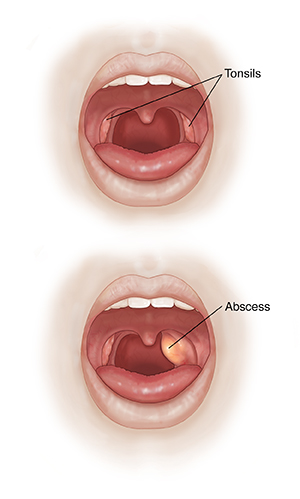Peritonsillar Abscess
A peritonsillar abscess is a collection of pus that forms near the tonsils. It is a complication of a bacterial infection of the tonsils (tonsillitis). The abscess causes one or both tonsils to swell. The infection and swelling may spread to nearby tissues. If tissues swell enough to block the throat, the condition can become life-threatening. It is also dangerous if the abscess bursts and the infection spreads or is breathed into the lungs. The goal is to treat a peritonsillar abscess before it gets worse and threatens your health.

Signs and symptoms of peritonsillar abscess
-
Severe sore throat (often worse on one side)
-
Swollen and enlarged tonsils
-
Fever and chills
-
Pain when swallowing or trouble opening the jaws of the mouth. This is also known as lockjaw or trismus.
-
Voice changes
-
Drooling
-
Swollen or tender glands in the neck
Diagnosing peritonsillar abscess
Your healthcare provider will examine you and look inside your mouth and throat. You will be asked about your symptoms and health history. Tests or procedures may be done as well, including those listed below:
-
Throat swab. This test checks for infection. It is done by wiping a sterile cotton swab in the back of the throat. The swab can be used for an immediate result. It can also be sent to a lab for a culture if needed.
-
Blood tests. These might be done to check how your body is responding to the infection.
-
Ultrasound or CT scans. These tests provide images of the abscess. They also help rule out other problems.
-
Needle aspiration. This procedure removes a sample of pus from the abscess with a needle. The sample is then sent to a lab to check for infection. Whenever possible, all the pus is removed from the abscess.
Treating peritonsillar abscess
The abscess itself can be treated. Treatment of the underlying infection is also needed. Common treatments are listed below.
-
Medicines. Antibiotics are needed to treat the underlying infection. These may be taken by mouth or given by IV. Pain relievers may also be given, if needed. Follow your healthcare provider's directions for taking these medicines.
-
Abscess d rainage. A procedure may be needed to drain the pus from the abscess. Pus may be removed from the abscess with a needle (needle aspiration). Or a small incision is made in the abscess. The pus is then drained and suctioned from the throat and mouth. This is called incision and drainage.
-
Tonsillectomy. This is surgery to remove the tonsils. It may be done if the abscess does not improve with medicines. It may also be done if you have frequent tonsil infections or abscesses.
Recovery and follow-up
Treating the bacterial infection generally relieves the problem. Once the infection goes away, you should recover completely. Follow up with your healthcare provider as directed. And if you develop another throat infection, see your healthcare provider right away.
© 2000-2025 The StayWell Company, LLC. All rights reserved. This information is not intended as a substitute for professional medical care. Always follow your healthcare professional's instructions.